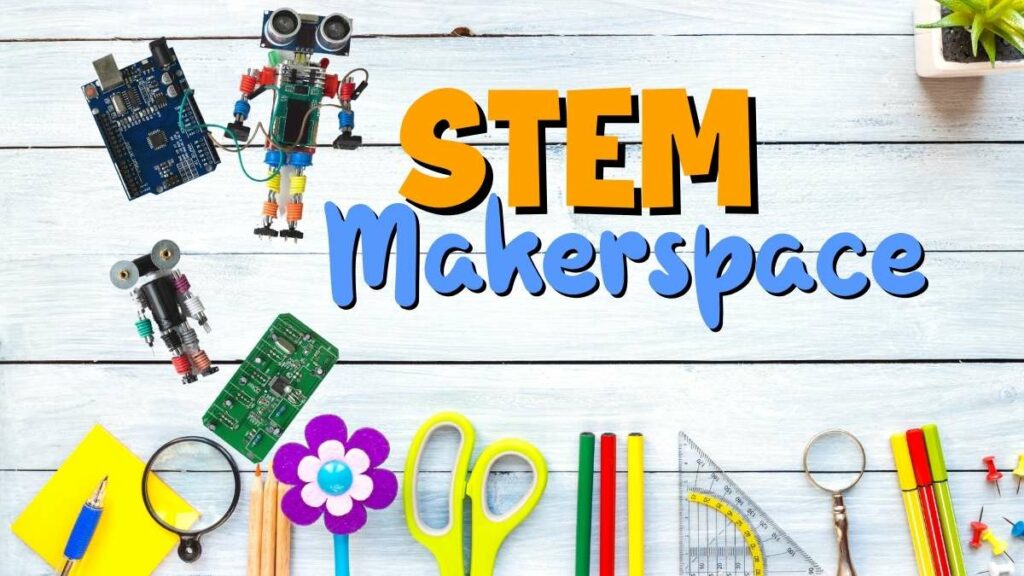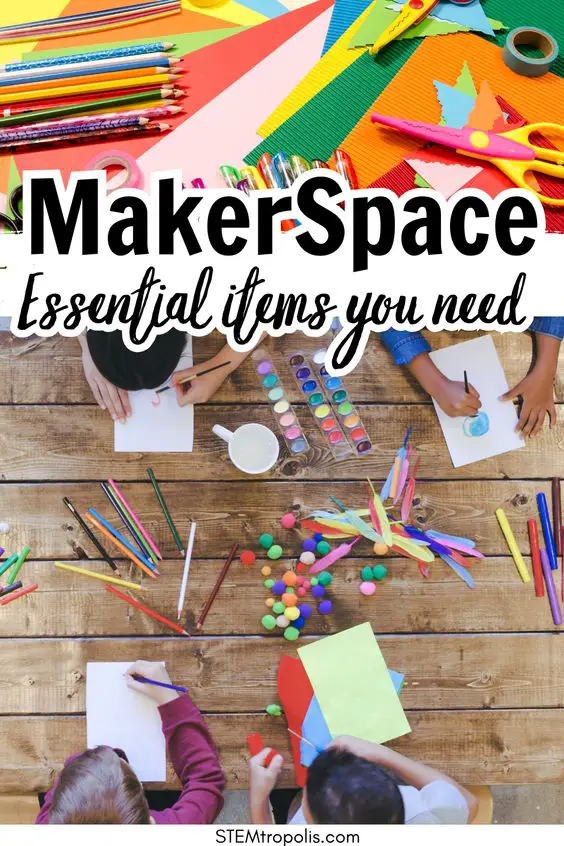STEM activities and projects can be a fun and engaging way for kids to learn and create. Having the materials you need for a variety of projects and STEM challenges easily accessible is key to getting started.
Make sure you have the essential items on hand so you can focus on building and not preparing. Whether you are a parent looking to set up a corner in your home or a teacher looking to create a STEM makerspace in your classroom or library, read on for must-have items to include in your toolkit. Let’s explore!

*We’re an affiliate – we may earn a commission through qualifying purchases from the links on this page. As always, thanks!*
Essential STEM Tools
When it comes to a STEM makerspace, there are some essential tools that you’ll want to make sure you have. Grade levels will vary, but scissors, paper, pens, ruler, glue and other basic materials should certainly be included. The beauty of having such supplies on hand is that they can be used in a variety of ways.
You’ll want some additional materials to work with, and some tech tools depending on what kind of projects you’re focusing on. We’ve found our makerspace is a combination of crafting supplies combined with some technical and science gear.
With these basics in place, kids will have the opportunity to explore their own creative ideas and invent new devices.
Stationary Materials
When it comes to stocking a makerspace, stationary materials are key. Aim to have a good selection of construction paper in various sizes, shapes, and colors. You’ll want paper to sketch or write on, as well as cutting out for various projects. We’ve got a whole post on STEM activities with paper if you’d like some ideas to get started.
We’ll often use pieces of corrugated cardboard boxes as a mat to put on our table so we’re not getting glue or paint or parts everywhere. You can also use boxes to organize the materials in your maker space, or to build with.
You’ll also want stuff to write and draw with. Make sure to have an assortment of pencils, pens, markers, crayons, and paints on hand so you’re ready to go for whatever project or STEM challenge you’re working on.
Craft Supplies
Craft supplies are great to have on hand for STEM makerspaces, and can help kids get creative with their projects.
Recycled materials like cardboard pieces, paper scraps, popsicle sticks (craft sticks),or plastic containers can all be used to create fun crafts and project ideas.
Yarn or string, beads, buttons, toothpicks, and other miscellaneous items can also be used to help build . Plus, these items are often inexpensive – so you don’t have to break the bank to get started!
With a few basic tools and some imagination, kids will be well on their way to creating amazing projects.
Adhesives
Whether you doing STEM challenges, STEAM projects, building, or crafting, you’re eventually going to need to stick one thing onto something else. You’ll need adhesives. It’s good to have options, so we always have the essentials on hand:
- Glue Sticks
- School Glue
- Hot Glue Gun
- Scotch Tape
- Duct Tape
Glue sticks are quick and (mostly) mess free. School glue is great for larger projects and, of course, making slime!
Hot glue guns are an awesome tool for crafting and prototyping. Scotch tape is great for holding things in place, and duct tape is great for those times when scotch tape doesn’t cut it. Also consider copper tape if you’re doing anything with circuitry experiments.
Check out our post on Learning Activities with Glue for Pre Schoolers
Recycled Materials
When it comes to stocking up a STEM makerspace, one of the most exciting elements is raiding the recycling bin! After all, what better way to get creative than by giving new life to old items? And when it comes to STEM activities, there are scraps of paper and cardboard everywhere waiting to be transformed. Here are just a few recycled materials that can help make your STEM space even more awesome:
- Toilet Paper Rolls: Perfect for making shakers, catapults, mazes, cars, castles, and so much more!
- Paper Towel Rolls: Make marble runs, launchers, towers, and more.
- Cardboard boxes: Transform these into musical instruments, rocket ships, robots, armor, or castles.
- Plastic bottles: Great for experiments needing to contain liquids, or creating windmills out of bottle caps.
- Egg Cartons: Perfect for organizing small parts, using as seed starters, or the basis of crafts and models.
- Popsicle Sticks: Great for building bridges and other structures, (and, of course, catapults!)
- Aluminum Cans – We’ve got a whole post on STEM activities with cans
- Glass Jars – these can be used for experiments with liquids, like vinegar and baking soda, or food coloring
- Egg Cartons – these are great for storing or organizing small parts like screws or nuts when building STEM kits. We’ve used them egg cartons as seed starters, as well as various projects, crafts, and models.
These items—and other recycled materials such as old CD’s – are just waiting to be reused in new and interesting ways! And don’t forget about the endless possibilities with cardboard pieces and scraps; from castles to robots – this versatile material is sure to inspire your makerspace creations.
STEM challenges with recycled materials can help teach kids how to make something useful out of items that would normally be thrown away.
Plus, they’re a great way to inspire kids who may not have access to lots of fancy STEM toys. With some imagination (and maybe a little glue!), you can turn everyday objects into something magical!
Check out our post on STEM Projects using Recycled Materials for some ideas!
Digital Technology
Now we’re getting into the fun stuff! When it comes to digital technology in your very own STEM lab, you’ve got a lot of tech and STEM gadgets to choose from.
You’ll want a computer, tablet, or smart device with internet access for a start.
From 3D printers to robotics kits, these tools provide the materials for some awesome projects and STEM challenges. (You never know how much you can do with a 3D printer until you have one – check out our Elementary Guide to 3D printing!)
For those working on more advanced projects, Arduino is an excellent choice. Arduino boards come with a wide range of sensors and actuators that can be used to create projects ranging from robotic arms and cars to automated home systems. With Arduino, even experienced coders can have endless possibilities for creativity and exploration.
No matter what kind of digital technology you decide to include in your makerspace, just remember that having the right tools will make it much easier for students to explore their ideas and master STEM concepts. On to electronic gadgets!
3D Printing Resources
When it comes to 3D printing, you can’t just dive in without the right resources. You need a solid foundation of materials and tools that will help you create quality prints. Here’s what you should have on hand:
- a 3D printer (we still love our Ender 3 Pro)
- Filament (Hatchbox PLA is our go to filament)
- Software (we use Cura, which is free)
- Extra parts and accessories – it’s great to have things like extra nozzles or build surfaces on hand
- Access to download or create models
- Memory cards to transfer models to your printer
First up is a 3D printer. This is the most important item in any maker space and should be chosen based on your budget and needs. Make sure to choose one with high resolution capabilities because this will determine the quality of your prints. And don’t forget to stock up on filament–the material used to print 3D objects–in different colors and sizes.
Finally, you’ll need software that can take digital designs and turn them into printable objects. Look for programs that offer easy-to-use features so that even beginners can get started quickly with 3D printing projects. Plus, don’t forget about extra parts like replacement nozzles or extruders for when things go wrong. With all these items in place, you’ll be ready to start printing!
To make sure your maker space works optimally for 3D printing projects, it’s important to consider the design of the space itself.
Electronics Gadgets and Tools
Electronics gadgets are essential to tech makerspaces, giving students the opportunity to explore the possibilities of technology. They can learn how to construct and design their own projects with circuitry, as well as test out their ideas in real-world applications.
| Item | Description |
|---|---|
| Arduino Board | An open-source microcontroller that helps in programming and controlling hardware. |
| Raspberry Pi | A tiny computer used for teaching basic computer science concepts. It can be connected to many different kinds of electronics gadgets. |
| Soldering Iron | Used for connecting pieces of metal together, solder is heated up by the soldering iron and then applied onto the joint between two components. A basic soldering kit has everything you need. |
| Screwdriver | Everything has screws, from opening a battery compartment to building kits. Check out a versatile kit wit lots of interchangeable bits like this one. If you have the bits, you can also use them in an electric screwdriver. We love the Black and Decker 20v series of tools; you can also use this as an electric drill. |
| Dremel or rotary tool | From carving, sanding, grinding, polishing, or cutting, a dremel or rotary tool comes in handy for a variety of jobs. A small rotary tool is great for small jobs in a makerspace. |
These items may seem expensive at first, but they’re relatively inexpensive compared to other hobbyist areas like photography or woodworking. Plus, they’re great investments since they can be reused over and over again. Students will get plenty of mileage out of these gadgets when it comes to experimenting and creating their own projects. So don’t be afraid to invest in quality electronics tools!
Now that we’ve discussed what electronic gadgets are needed in a STEM makerspace, let’s move on to programming software.
Programming Software
Though it’s not something that will get nestled into a container or sit on a shelf, software makes a great tool for any makerspace.
Scratch is a great place to start for young coders, as it features a graphical interface that makes coding simple and fun. For more advanced learners, Python is an excellent choice as its syntax is relatively straightforward and it’s incredibly versatile. Both programs can be accessed online or downloaded for free onto your computer.
If you’ve invested in a robot kit, chances are it has an app to download. (And there are a ton of fun STEM based apps to use on their own.)
If you’re doing projects with Arduino or Raspberry Pi, you’ll need software for those as well.
No matter what kind of project you’re planning on tackling in your STEM makerspace, having the right programming tools is essential for success! The next step? Making sure all the equipment is safe…
Space Design Considerations
When it comes to designing a STEM makerspace, there’s no one-size-fits-all approach. The space should be tailored to fit the specific needs of the makers in the space. Considerations like traffic flow, ventilation, electrical outlets and safety features are all important factors to keep in mind. You’ll also want to make sure that you have plenty of room for your tools and supplies.
When selecting furniture for your makerspace, look for pieces that are both practical and comfortable. Tables should be adjustable and provide enough space for multiple people to work at once. Chairs should be ergonomic and designed to support long periods of sitting or standing. Shelves and containers are essential for storing materials, tools, and finished projects.
Most of the time, you’ll wind up starting with what you have on hand. Our main makerspace is often the dining room table. We use an old library card catalog as drawers to organize our tools and supplies. The 3D printer has its own space in another part of the house – well, because it can’t live on the dining room table.
Above all else, you want your makerspace to be inviting and inspiring! It should feature plenty of light, comfortable seating areas for collaboration and conversation, bright colors on the walls, artworks or inspirational quotes on display – whatever it takes to make people feel welcome and inspired!
Storage Solutions
So, there’s a lot that goes into a makerspace. How do you keep all those materials and tools organized? Storage solutions are key to any successful STEM makerspace. The first thing to consider is what type of materials will be stored within the space. For larger items like 3D printers and robotic arms, shelves or drawers for storing parts and tools might work best. These can come in a variety of styles, from open shelving systems to closed cabinets.
For smaller items like screws, nuts, bolts, and electronic components, organizing bins with dividers can help keep everything neat and orderly. Labeling each bin with its contents can also be helpful so that users don’t have to dig around looking for the right part or tool. We’ve also used empty egg cartons to hold small parts!
It’s important to remember that safety should always be at the forefront when designing a storage system; make sure that sharp objects like knives or scissors are kept away from small children who may be in the space.
Having an area specifically designated for messy projects such as painting or carpentry is also important. This will ensure that all areas of the makerspace stay clean and organized while allowing users to work on their projects without worrying about making a mess. With these simple storage solutions in place, your STEM makerspace will be ready for any challenge!
Safety Equipment
Often overlooked when considering a makerspace is safety gear. STEM makerspace, safety equipment is the guardrail that helps keep its users from harm.
Here are a few must-have items for your STEM makerspace:
- Goggles – Safety goggles are essential to protect eyes from any flying debris or hazardous materials that may be used in your STEM makerspace. Besides, who doesn’t love looking like a mad scientist?!
- Gloves – gloves can protect from cuts and burns from tools, as well as stains from paint or markers.
- Fire Extinguisher – Depending on what kids of experiments you’re doing, you may want one of these on hand. If you’re doing anything that may spark or flame, it’s better to have a fire extinguisher and not need it than be unprepared for an emergency (trust us on this one, as it’s often overlooked at home.) Fire extinguishers come in different types and sizes, so make sure you choose the right one for your space. For a less messy option, you may want to have a fire blanket on hand.
When it comes to safety equipment, don’t skimp on quality! Investing in the best will help ensure that your STEM makerspace stays safe and secure for all its users.

Wrap Up – What You Need for Your Own Makerspace
If you’ve got a makerspace for STEM set up, then you’re ready to start building and won’t waste your time and motivation gather your materials. With the right tools, materials, craft supplies, recycled materials, digital technology, safety equipment and 3D printing resources in place, your space is ready to be used NOW!
Ultimately, your materials will depend on the types of projects you’ll be doing. You can choose what works best for your group and space, and make sure that everything has its own designated area. That way you won’t have a jumble of things lying around where they don’t belong – and can find things when you need them.
Don’t forget that a makerspace isn’t just about having the right materials – it’s about creating an environment for creativity and innovation. It should be like a blank canvas waiting for ideas to be painted onto it – full of possibility and excitement!
Now that you’ve got your makerspace set up, check out some of our most popular activities to put your new toolkit to work:
Recycled Materials
Cardboard Tubes
Popsicle/Craft sticks
Plastic Bottles
Plastic Cups
Aluminum Cans
Pipe Cleaners
Paper Clips
STEM Kits
Robotics Kits




